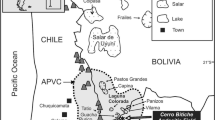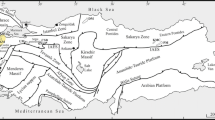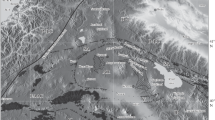Abstract
Volcanism extending over 11 Ma is represented in the rocks of the Nevados de Payachata region, culminating in the formation of two large composite stratocones within the last 500 000 years. Chemically distinct mafic magmas are erupted at a number of parasitic centers. These cannot be related to each other by crystal fractionation and do not appear to be direct parents for the differentiated suites of the composite cones. Two distinct trends are defined by the intermediate and evolved rocks; a high LILE (large ion lithophile element), TiO2 and Ce/Yb lineage among the youngest rocks (including the two major stratocones), and a more typical calc-alkaline trend among the older (>1 Ma) rock types. Within individual volcanic centers, differentiation involves fractionation of plagioclase, pyroxene and hornblende, with biotite and K-feldspar in the more-evolved rock types. Isotopic compositions (Sr, Pb, Nd, O) vary little with differentiation from basaltic andesite to rhyolite, or with age. Contamination during differentiation from basalt to rhyolite may occur, but the most mafic rocks erupted in the region are already enriched in incompatible trace elements and therefore may be insensitive to the effects of interaction with the crust. The majority of data are similar to “baseline” compositions (Cenozoic parental magmas) from other parts of the central Andes and may reflect a relatively homogeneous magma source (or source mixture) throughout this central volcanic zone (CVZ), which is distinct from the southern and northern Andes, and from island-arc volcanic rocks.
The detailed study of Nevados de Payachata serves as a useful reference against which to assess magmatism in general in the CVZ. The possibility that central Andean magmas are generated from an enriched subcontinental-lithosphere mantle wedge is rejected on the basis of: (1) thermal considerations (subcontinental mantle lithosphere is probably cold and refractory); (2) lack of consistency between the tectonic history of the region and geochemical variations through time. Instead, parental magmas in the CVZ are thought to be generated by mixing between normal arc magmas originating in the depleted mantle wedge followed by contamination and homogenization with lower crustal melts. In the central Andes, the extent of contamination increased greatly as the crust thickened due to crustal shortening within the last 20 Ma, the thicker crust providing an effective filter to trap and differentiate magma batches repeatedly during ascent.
Similar content being viewed by others
References
Barreiro BA, Clark AH (1984) Lead isotopic evidence for evolutionary changes in magma-crust interaction, Central Andes, southern Peru. Earth Planet Sci Lett 69:30–42
Cobbing EJ, Ozard JM, Snelling NJ (1977) Reconnaissance geochronology of the crystalline basement rocks of the Coastal Cordillera of southern Peru. Geol Soc Am Bull 88:241–246
Dasch EJ (1981) Lead isotopic compositions of metalliferous sediments from the Nazca Plate. Geol Soc Am Mem 154:199–209
Davidson JP, Dungan MA, Ferguson KM, Colucci MT (1987) Crust-magma interactions and the evolution of arc magmas: The San Pedro-Pellado Volcanic Complex, Southern Chilean Andes. Geology 15:443–446
Davidson JP, Ferguson KM, Colucci MT, Dungan MA (1988) The origin and evolution of magmas from the San Pedro-Pellado Volcanic Complex, S. Chile: Multicomponent sources and open system evolution. Contrib Mineral Petrol 100:429–445
de Silva SL (1987) Large volume explosive silicic volcanism in the central Andes of N Chile. Unpublished PhD thesis, Open University, UK
de Silva SL (1989) The Altiplano-Puna volcanic complex of the central Andes. Geology 17:1102–1106
Deruelle G, Harmon RS, Moorbath SM (1983) Combined Sr−O isotope relationships and petrogenesis of Andean volcanics of South America. Nature 302:814–816
Dudas FO, Carlson RW, Eggler DH (1987) Regional Middle Proterozoic enrichment of the subcontinental mantle source of igenous rocks from central Montana. Geology 15:22–25
England PC, Thompson AB (1984) Pressure-temperature-time paths of regional metamorphism. I. Heat transfer during the evolution of regions of thickened continental crust. J Petrol 25:894–928
Fitton JG, James D, Kempton PD, Ormerod DS, Leeman WP (1988) The role of lithospheric mantle in the generation of Late Cenozoic basic magmas in the western United States. J Petrol Special Lithosphere Issue: 331–349
Francis PW, Moorbath S, Thorpe RS (1977) Strontium isotope data for Recent andesites in Ecuador and North Chile. Earth Planet Sci Lett 37:197–202
Francis PW, Thorpe RS, Moorbath S, Kretzschmar GA, Hammill M (1980) Strontium isotope evidence for crustal contamination of calc alkaline volcanic rocks from Cerro Galan, Northwest Argentina. Earth Planet Sci Lett 48:257–267
Francis PW, Sparks RSJ, Hawkesworth CJ, Thorpe RS, Pyle DM, Tait SR, Mantovani MS, McDermott F (1989) Petrology and geochemistry of the Cerro Galan caldera, northwest Argentina. Geol Mag 126:515–547
Green TH (1982) Anatexis of mafic crust and high pressure crystallization of andesite. In: Thorpe RS (ed) Andesites. Wiley, New York, pp 465–487
Halliday AN, Stephens WE, Hunter RH, Menzies MA, Dickin AP, Hamilton PJ (1985) Isotopic and chemical constraints on the building of the deep Scottish lithosphere. Scott J Geol 21:465–491
Hanson GN (1978) The application of trace elements to the petrogenesis of igneous rocks of granitic composition. Earth Planet Sci Lett 38:26–43
Harmon RS, Thorpe RS, Francis PW (1981) Petrogenesis of Andean andesites from combined O−Sr isotope relationships. Nature 290:396–399
Harmon RS, Barreiro BA, Moorbath S, Hoefs J, Francis PW, Thorpe RS, Deruelle B, McHugh J, Viglinio JA (1984) Regional O−Sr-and Pb-isotope relationships in late cenozoic calc-alkaline lavas of the Andean Cordillera. J Geol Soc London 141:803–822
Hawkesworth CJ, Ellam R (1989) Chemical fluxes and wedge replenishment rates along recent destructive plate margins. Geology 17:46–49
Hawkesworth CJ, Hammill M, Gledhill AR, van Calsteren P, Rogers G (1982) Isotope and trace element evidence for latestage intracrustal melting in the High Andes. Earth Planet Sci Lett 51:297–308
Henry SG, Pollack HN (1988) Terrestrial heat flow above the Andean subduction zone in Bolivia and Peru. J Geophys Res 93:15153–15162
Hickey RL, Gerlach DC, Frey FA (1984) Geochemical variations in volcanic rocks from central-south Chile (33°–42°S): Implications for their petrogenesis. In: Harmon RS, Barreiro BA (ed) Andean magmatism, chemical and isotopic constraints. Shiva, Nantwich Cheshire, pp 72–95
Hickey RL, Frey FA, Gerlach DC, Lopez-Escobar L (1986) Multiple sources for basaltic arc rocks from the Southern Volcanic Zone of the Andes (34°–41°S): Trace element and isotopic evidence for contributions from subducted oceanic crust, mantle and continental crust. J Geophys Res 91:5963–5983
Hildreth WE, Moorbath S (1988) Crustal contributions to arc magmatism in the Andes of Central Chile. Contrib Mineral Petrol 98:455–499
Isacks BL (1988) Uplift of the Central Andean Plateau and bending of the Bolivian Orocline. J Geophys Res 93:3211–3231
Ito E, White WM, Gopel C (1987) The O, Sr, Nd and Pb isotope geochemistry of MORB. Chem Geol 62:157–176
Jagoutz E, Palme H, Baddenhausen H, Blum K, Cendales M, Dreibus G, Spettel B, Lorenz V, Wanke H (1979) The abundances of major, minor and trace elements in the earth's mantle as derived from primitive ultramafic nodules. Proceedings Lunar Planet Sci Conference 10:2031–2050
James DE (1982) A combined O, Sr, Nd and Pb isotopic and trace element study of crustal contamination in the central Andean lavas, I. Local geochemical variations. Earth Planet Sci Lett 57:47–62
James DE, Brooks C, Cuyubamba A (1976) Andean Cenozoic volcanism: Magma genesis in the light of strontium isotopic composition and trace element geochemistry. Bull Geol Soc Am 87:592–600
Johnston AD, Wyllie PJ (1988) Constraints on the origin of Archean trondhjemites based on phase relationships of Nuk gneiss with H2O at 15 kbar. Contrib Mineral Petrol 100:35–46
Kyser TK (1986) Stable isotope variations in the mantle. In: Valley JW, Taylor HP Jr, O'Neil JR (eds) Stable isotopes in high temperature geological processes. Reviews Mineralogy 16:141–164
Lambert IB, Wyllie PJ (1972) Melting of gabbro (quartz eclogite) with excess water to 35 kilobars, with geological applications. J Geol 80:693–708
Litherland M, Klinck BA, O'Connor EA, Pitfield PEJ (1985) Andean-trending mobile belts in the Brazilian shield. Nature 314:345–348
Manhes G, Minster J-F, Allegre CJ (1978) Comparitive uranium-thorium-lead and rubidium strontium of St. Severin amphoterite: consequences for early solar system chronology. Earth Planet Sci Lett 39:14–24
Margaritz M, Whitford DJ, James DE (1978) Oxygen isotopes and the origin of high 87Sr/86Sr andesites. Earth Planet Sci Lett 40:220–230
McMillan NJ, Harmon RS, Moorbath S, Lopez-Escobar L, Strong DF (1989) Crustal sources involved in continental arc magmatism: A case study of volcan Mocho-Choshuenco, southern Chile. Geology 17:1152–1156
Moorbath S, Taylor PN (1989) The Andean Nd−Sr isotopic array: An expression of crust-mantle mixing (abstract). IAVCEI General Assembly; New Mexico Bureau of Mines and Mineral Resources Bulletin, 131:193
Mukasa SB (1986) Common Pb isotopic compositions of the Lima, Arequipa and Toquepala segments in the coastal batholith, Peru: implications for magma genesis. Geochim Cosmochim Acta 50:771–782
Nelson DR, McCulloch MT, Sun SS (1986) The origins of ultrapotassic rocks as inferred from Sr, Nd and Pb isotopes. Geochim Cosmochim Acta 50:231–245
Nye CJ, Reid MR (1986) Geochemistry of primary and least fractionated lavas from Okmok volcano, central Aleutians: Implications for arc magmagenesis. J Geophys Res 91:10271–10287
Pankhurst RJ, O'Nions PK (1973) Determination of Rb/Sr and 87Sr/86Sr ratios of some standard rocks and evaluation of X-ray fluorescence spectrometry in Rb−Sr geochemistry. Chem Geol 12:127–136
Plank T, Langmuir CH (1988) An evaluation of the global variations in the major clement chemistry of arc basalts. Earth Planet Sci Lett 90:349–370
Pollack HN (1986) Cratonization and thermal evolution of the mantle. Earth Planet Sci Lett 80:175–182
Richard P, Shimizu N, Allegre CJ (1976) 143Nd/144Nd, a natural tracer: an application to oceanic basalts. Earth Planet Sci Lett 31:269–278
Rogers GR (1985) A geochemical traverse across the north Chilean Andes. Unpublished PhD thesis, The Open University, UK
Rogers GR, Hawkesworth CJ (1989) A geochemical traverse across the north Chilean Andes: evidence for crust generation from the mantle wedge. Earth Planet Sci Lett 91:271–285
Shackleton RM, Ries AC, Coward MP, Cobbold PR (1979) Structure, metamorphism and geochromology of the Arequipa massif of coastal Peru. J Geol Soc London 136:195–214
Sun SS (1980) Lead isotopic study of young volcanic rocks from mid-ocean ridges, ocean islands and island arcs. Philos Trans R Soc London A 297:409–445
Taylor HP Jr (1980) The effects of assimilation of country rocks by magmas on 18O/16O and 87Sr/86Sr isotope systematics in igneous rocks. Earth Planet Sci Lett 47:243–254
Taylor HP Jr (1986) Igneous rocks II Isotopic case studies of circumpacific magmatism. In: Valley JW, Taylor HP Jr, O'Neil JR (eds) Stable isotopes in high temperature geological processes. Reviews Mineralog 16:273–317
Taylor HP Jr, Sheppard SMF (1986) Igneous rocks: I. Processes of isotopic fractionation and isotope systematics. In: Valley JW, Taylor HP Jr, O'Neil JR (eds) Stable isotopes in high temperature geological processes. Reviews Mineralogy 16:227–271
Taylor SR, McLennan SM (1985) The continental crust: its composition and evolution. Blackwell, Oxford
Thompson AB, England PC (1984) Pressure-temperature-time paths of regional metamorphism II. Their inference and interpretation using mineral assemblages in metamorphic rocks. J Petrol 25:929–955
Thompson AB, Tracy RJ (1979) Model system for anatexis of pelitic rocks. II. Facies series melting and reactions in the system CaO−KAlO2−NaAlO2−Al2O3−SiO2−H2O. Contrib Mineral Petrol 70:429–438
Thompson RN, Morrison MA, Dickin AP, Hendry GL (1983) Continental flood basalts... arachnids rule O.K.?. In: Hawkesworth CJ, Norry MJ (eds) Continental basalts and mantle xenoliths. Shiva, Nantwich Cheshire, pp 158–185
Thorpe RS, Francis PW, Moorbath S (1979) Rare earth and Sr-isotope evidence concerning the petrogenesis of north Chilean ignimbrites. Earth Planet Sci Lett 42:359–367
Thorpe RS, Francis PW, O'Callaghan L (1984) Relative roles of source composition, fractional crystallization and crustal contamination in the petrogenesis of Andean volcanic rocks. Philos Trans R Soc London 310:675–692
Tilton GR, Barreiro BA (1980) Origin of lead in Andean calc alkaline lavas, southern Peru. Science 210:1245–1247
Unruh DM, Tatsumoto M (1976) Lead isotopic composition and uranium, thorium and lead concentrations in sediments and basalts from the Nazca Plate. Inital Report DSDP 34:341–347
Wickham SM (1987) The segregation and emplacement of granitic magmas. J Geol Soc London 144:281–297
Woodhead JD, Harmon RS, Fraser DG (1987) O, S, Sr, and Pb isotope variations in volcanic rocks from the Northern Mariana Islands: implications for crustal recycling in intra-oceanic arcs. Earth Planet Sci Lett 83:39–52
Wörner G, Harmon RS, Davidson JP, Moorbath S, Turner DL, McMillan NJ, Nye C, Lopez-Escobar L, Moreno H (1988) The Nevados de Payachata Volcanic Region (18° S/69° W, N. Chile): I. Geological, geochemical and isotopic observations. Bull Volcanol 50:287–303
Wyllie PW (1984) Subduction products according to experimental prediction. Bull Geol Soc Am 93:468–476
Author information
Authors and Affiliations
Rights and permissions
About this article
Cite this article
Davidson, J.P., McMillan, N.J., Moorbath, S. et al. The Nevados de Payachata volcanic region (18°S/69°W, N. Chile) II. Evidence for widespread crustal involvement in Andean magmatism. Contrib Mineral Petrol 105, 412–432 (1990). https://doi.org/10.1007/BF00286829
Received:
Accepted:
Issue Date:
DOI: https://doi.org/10.1007/BF00286829




